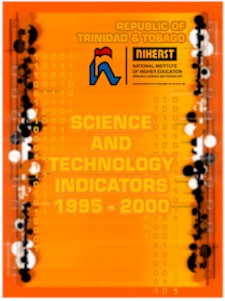
This publication presents a compendium of education statistics on enrolment in primary, secondary and tertiary institutions together with examination results at the secondary and tertiary levels. The edition also includes expenditure on S&T activities and education, data on key social and economic indicators of the Republic of Trinidad and Tobago and tabulations on graduates with tertiary level qualification. This provides essential data on the supply of human resource personnel in the various fields of S&T.
Summary of Main Findings
Public Secondary School Teachers
- Between 1995/1996 and 1999/2000, the total number of public secondary school teachers increased marginally by 207 or 4%. This growth was attributed to the number of females which rose by 11% as the male teacher population declined by 4%.
- The number of teachers with university degrees consistently out-numbered those without degrees by a ratio of approximately 1.8:1. Of the teachers with university degrees, a similar proportion was professionally trained and untrained in 1995/1996. In 1999/2000, however, 43% of these teachers possessed professional training compared with 57% being untrained. Among teachers without university degrees, 64% were trained and 36% were untrained in 1995/1996. In 1999/2000, a similar percentage of trained and untrained teachers was shown. Compared with 1995/1996, the data in 1999/2000 show that the number of trained secondary school teachers decreased by 14%, from 2,753 to 2,374 while untrained teachers increased by 27%, from 2,192 to 2,778. This situation is likely to impact negatively on the quality of secondary education.
Public Technical Institutions
- Total enrolment in the technician courses declined from 1,756 in 1996/1997 to 1,267 in 1999/2000 (39%) and then increased to 1,636 in 2000/2001. Enrolment in Mechanical/Production Engineering and Electrical/Electronic Engineering accounted for more than 50% of total enrolment. Except for Science Laboratory, male participation dominated that of female. In the academic year 2000/2001, 81% (1,333) of the total enrolment were males and 19% (303) females. The data revealed a decreasing trend in enrolment in Draughtsmanship.
- The total number of students writing the examinations in various technician courses increased by 25%, from 904 in 1996 to 1,127 in 1998, but then declined by 39% to 686 in the year 2000. Between 1998 and 2000 the only increase among the engineering courses was seen in Mechanical Engineering. The total percentage pass rate of 46% in the year 2000 showed slight improvement when compared with earlier periods. The data suggest that a critical review is required in the key subject areas of Civil, Electrical/Electronics, Mechanical and Telecommunication Engineering where the pass rates were below 50%.
Students' Registration at The University of the West Indies
- Registration of Trinidad and Tobago students in first degree programmes at The University of West Indies increased from 3,470 in 1995/1996 to 4,153 in 1999/2000 - a growth of 20%. Between 1995/1996 and 1999/2000 registration increased in Engineering (39%) and Natural Sciences (20%) but declined in Agricultural Sciences (35%). From a gender perspective, male registration rose by 8% compared with 29% in the case of female. Except for Engineering, female registration out-numbered male in all other faculties.
- Overall, registration of Trinidad and Tobago nationals in higher degrees at The University of the West Indies rose from 993 in 1995/1996 to 1,269 in 1999/2000, representing a 28% increase. But registration in the 1999/2000 academic year recorded a marginal decline of 3% compared with 1998/1999. The Faculties of Engineering and Social Sciences comprised more than fifty percent (50%) of all students registered at the higher degree level. Natural Sciences accounted for approximately 14% and Agricultural Sciences slightly under 10% of total registration. In the academic year 1999/2000, a larger number of females compared with males was registered in each faculty except in Engineering. Significant growth was observed in female registration between 1995/1996 and 1999/2000 in Natural Sciences (76%) and Engineering (75%).
Expenditure on Research and Development (R&D)
- Expenditure on R&D increased by 37%, from $45.6 million in 1996 to $62.4 million in 1999. The public sector was the major source of funding in research activities. From 1996 to 1999, expenditure on R&D was less than one half of one percent of Gross Domestic Product.






